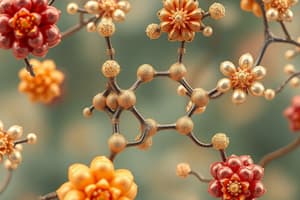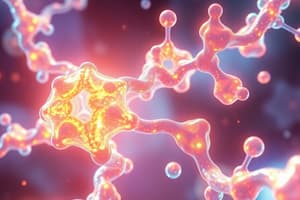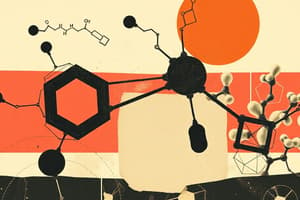Podcast
Questions and Answers
Which type of molecule is NOT a polymer of smaller subunit molecules?
Which type of molecule is NOT a polymer of smaller subunit molecules?
Cells decrease entropy without expending energy.
Cells decrease entropy without expending energy.
False (B)
What type of reaction links monomers together to form polymers, releasing a water molecule?
What type of reaction links monomers together to form polymers, releasing a water molecule?
dehydration reaction
Proteins are made up of ______.
Proteins are made up of ______.
Signup and view all the answers
Match the biological molecules with their primary function:
Match the biological molecules with their primary function:
Signup and view all the answers
Which of the listed chemical features are associated with carbohydrates?
Which of the listed chemical features are associated with carbohydrates?
Signup and view all the answers
Phosphodiester bonds link amino acids together to form proteins.
Phosphodiester bonds link amino acids together to form proteins.
Signup and view all the answers
According to the diagram, what does 'β' indicate regarding the position of an OH group attached to a carbon in the ring?
According to the diagram, what does 'β' indicate regarding the position of an OH group attached to a carbon in the ring?
Signup and view all the answers
A glycosidic β 1->4 linkage involves a condensation reaction between a β1 OH on sugar A and an α4 OH on sugar B.
A glycosidic β 1->4 linkage involves a condensation reaction between a β1 OH on sugar A and an α4 OH on sugar B.
Signup and view all the answers
What type of reaction occurs between two sugars to form a glycosidic linkage?
What type of reaction occurs between two sugars to form a glycosidic linkage?
Signup and view all the answers
Positions of the OH groups attached to each carbon in the ring are described as being either UP (above the plane of the ring) = ______.
Positions of the OH groups attached to each carbon in the ring are described as being either UP (above the plane of the ring) = ______.
Signup and view all the answers
Match the following descriptions with the correct term:
Match the following descriptions with the correct term:
Signup and view all the answers
Based on the content, what is the primary structural difference between starch and cellulose that accounts for human digestibility?
Based on the content, what is the primary structural difference between starch and cellulose that accounts for human digestibility?
Signup and view all the answers
Given a sugar molecule has multiple OH groups located at various positions throughout the structure, linked sugars are capable of forming a limited array of branched polysaccharide structures.
Given a sugar molecule has multiple OH groups located at various positions throughout the structure, linked sugars are capable of forming a limited array of branched polysaccharide structures.
Signup and view all the answers
How many different ways are there to form D-glucose disaccharides, according to the content provided?
How many different ways are there to form D-glucose disaccharides, according to the content provided?
Signup and view all the answers
The position of the OH groups attached to each carbon in the ring are described as being either DOWN (below the plane of the ring) = ______.
The position of the OH groups attached to each carbon in the ring are described as being either DOWN (below the plane of the ring) = ______.
Signup and view all the answers
Which type of linkage can humans digest in starch?
Which type of linkage can humans digest in starch?
Signup and view all the answers
Lipids are hydrophilic membrane barriers.
Lipids are hydrophilic membrane barriers.
Signup and view all the answers
What chemical feature do triglycerides have?
What chemical feature do triglycerides have?
Signup and view all the answers
Phospholipids are considered to be ______ in chemical nature.
Phospholipids are considered to be ______ in chemical nature.
Signup and view all the answers
In GM2 gangliosides, what replaces the phosphate/polar head group found in phospholipids?
In GM2 gangliosides, what replaces the phosphate/polar head group found in phospholipids?
Signup and view all the answers
What enzyme mutation causes Tay-Sachs disease?
What enzyme mutation causes Tay-Sachs disease?
Signup and view all the answers
What does the 1st Law of Thermodynamics state?
What does the 1st Law of Thermodynamics state?
Signup and view all the answers
Cells operate as isolated systems according to the laws of thermodynamics.
Cells operate as isolated systems according to the laws of thermodynamics.
Signup and view all the answers
Amino acids are building blocks of ______.
Amino acids are building blocks of ______.
Signup and view all the answers
Match the following terms to their descriptions:
Match the following terms to their descriptions:
Signup and view all the answers
What characterizes a spontaneous reaction in the context of thermodynamics?
What characterizes a spontaneous reaction in the context of thermodynamics?
Signup and view all the answers
According to the 2nd Law of Thermodynamics, all processes in the universe tend to increase __________.
According to the 2nd Law of Thermodynamics, all processes in the universe tend to increase __________.
Signup and view all the answers
Match the thermodynamic laws to their descriptions:
Match the thermodynamic laws to their descriptions:
Signup and view all the answers
Which of the following amino acids are classified as acidic?
Which of the following amino acids are classified as acidic?
Signup and view all the answers
All amino acid side chains are nonpolar and do not ionize at neutral pH.
All amino acid side chains are nonpolar and do not ionize at neutral pH.
Signup and view all the answers
What does ATP stand for?
What does ATP stand for?
Signup and view all the answers
The basic amino acids include histidine, lysine, and __________.
The basic amino acids include histidine, lysine, and __________.
Signup and view all the answers
Match the following amino acids with their classification:
Match the following amino acids with their classification:
Signup and view all the answers
Which type of chemical features do nucleotides exhibit?
Which type of chemical features do nucleotides exhibit?
Signup and view all the answers
Nucleotides are only found as components of DNA and cannot act as energy carriers.
Nucleotides are only found as components of DNA and cannot act as energy carriers.
Signup and view all the answers
What type of order do living things create and maintain?
What type of order do living things create and maintain?
Signup and view all the answers
The pK value represents the pH at which __________ of all molecules of an ionizable substance are charged.
The pK value represents the pH at which __________ of all molecules of an ionizable substance are charged.
Signup and view all the answers
Match the following compounds with their roles:
Match the following compounds with their roles:
Signup and view all the answers
Flashcards
Monomers
Monomers
Small subunit molecules that link to form polymers.
Polymers
Polymers
Large molecules made from linked monomers.
Carbohydrates
Carbohydrates
Molecules made of sugar monomers for energy and support.
Lipids
Lipids
Signup and view all the flashcards
Proteins
Proteins
Signup and view all the flashcards
Nucleic acids
Nucleic acids
Signup and view all the flashcards
Condensation reactions
Condensation reactions
Signup and view all the flashcards
α and β configurations
α and β configurations
Signup and view all the flashcards
Glycosidic linkage
Glycosidic linkage
Signup and view all the flashcards
Polysaccharide structure
Polysaccharide structure
Signup and view all the flashcards
Starch vs Cellulose
Starch vs Cellulose
Signup and view all the flashcards
D-Glucose disaccharides
D-Glucose disaccharides
Signup and view all the flashcards
Positions of OH groups
Positions of OH groups
Signup and view all the flashcards
Branched polysaccharides
Branched polysaccharides
Signup and view all the flashcards
Energy storage vs Structural molecules
Energy storage vs Structural molecules
Signup and view all the flashcards
Starch vs Cellulose Digestion
Starch vs Cellulose Digestion
Signup and view all the flashcards
Triglycerides
Triglycerides
Signup and view all the flashcards
Amphipathic
Amphipathic
Signup and view all the flashcards
Gangliosides
Gangliosides
Signup and view all the flashcards
GM2 Ganglioside
GM2 Ganglioside
Signup and view all the flashcards
Tay-Sachs Disease
Tay-Sachs Disease
Signup and view all the flashcards
b-Hexosaminidase A
b-Hexosaminidase A
Signup and view all the flashcards
Amino Acids
Amino Acids
Signup and view all the flashcards
Protein Structure Directionality
Protein Structure Directionality
Signup and view all the flashcards
1st Law of Thermodynamics
1st Law of Thermodynamics
Signup and view all the flashcards
2nd Law of Thermodynamics
2nd Law of Thermodynamics
Signup and view all the flashcards
Spontaneous Reaction
Spontaneous Reaction
Signup and view all the flashcards
Energetically Favorable Reactions
Energetically Favorable Reactions
Signup and view all the flashcards
Cells and Energy Exchange
Cells and Energy Exchange
Signup and view all the flashcards
Ionizable amino acids
Ionizable amino acids
Signup and view all the flashcards
Acidic amino acids
Acidic amino acids
Signup and view all the flashcards
Basic amino acids
Basic amino acids
Signup and view all the flashcards
pK value
pK value
Signup and view all the flashcards
Nucleotides
Nucleotides
Signup and view all the flashcards
ATP
ATP
Signup and view all the flashcards
Chemical structure of nucleotides
Chemical structure of nucleotides
Signup and view all the flashcards
Polar nature of nucleotides
Polar nature of nucleotides
Signup and view all the flashcards
Order in living things
Order in living things
Signup and view all the flashcards
Functions of proteins
Functions of proteins
Signup and view all the flashcards
Study Notes
Biological Molecules: Building Blocks of Cells
- Cells are composed of a specific set of small carbon-based molecules, fundamentally similar across all living organisms.
- Essential molecules within cells are polymers of smaller subunits (monomers).
- Carbohydrates, composed of sugar monomers, function as energy storage and structural components within cells.
- Lipids, made from fatty acids (often linked to glycerol), serve as energy storage and assemble membranes.
- Proteins, comprised of amino acids, carry out most cellular functions.
- Nucleic acids, from nucleotide monomers, store genetic information and provide short-term energy.
- Cells maintain order (reduce entropy) at the cost of energy expenditure.
Chemical Composition of a Bacterial Cell (Approximate)
- Water comprises 70% of a bacterial cell's weight.
- Inorganic ions account for 1%.
- Sugars and precursors make up 1%.
- Amino acids and precursors total 0.4%.
- Nucleotides and precursors equal 0.4%.
- Fatty acids and precursors are found at 1%.
- Other small molecules add up to around 0.2%.
- Macromolecules (proteins, nucleic acids, and polysaccharides) constitute 26%.
- Roughly 3000 different types of macromolecules exist.
- There are approximately 250 types of sugars and precursors.
- About 100 types are seen in amino acids and precursors.
- Approximately 100 types of molecules are found in nucleotides and precursors.
- Around 50 types exist for fatty acid and other precursors.
Components of Cells
- Water (70%) is the primary component of cells.
- Other small molecules (~300) account for a smaller proportion.
- Macromolecules (proteins, nucleic acids, polysaccharides) account for about 3000 different molecules.
- These molecules include proteins (15%), polysaccharides (2%), small molecules/ions (4%), phospholipids (2%), DNA/RNA (7%).
Formation of Polymers
- Monomers are joined to form polymers through dehydration (condensation) reactions.
- A water molecule is removed during this process.
Carbohydrates
- Carbohydrate structures are generally linear chains or ring structures.
- These structures have multiple hydroxyl (OH) groups attached.
- Sugars undergo various linkages, each with numbered carbons (starting from the oxygen in the ring).
- Key linkage classifications include alpha (α) and beta (β), based on the OH group's position.
Lipids
- Lipids have hydrocarbon tails and polar carboxyl groups (COOH).
- These properties make lipids hydrophobic.
- Triglycerides are a form of lipid used for energy storage.
- Phospholipids, a specific type of lipid, form cell membranes due to their amphipathic nature (having both hydrophilic and hydrophobic regions).
Amino Acids
- Amino acids have a uniform structure with an amino group (-NH2) and a carboxyl group (-COOH) bonded to a central carbon atom.
- The side chains (R groups) vary, defining each unique type of amino acid.
- Amino acids readily ionize at neutral pH.
- Amino acids can be acidic, basic, or electrically charged among other properties.
Nucleotides
- Nucleotides have a uniform structure consisting of a nitrogenous base, a five-carbon sugar (ribose or deoxyribose), and a phosphate group.
- Nitrogenous bases vary, with notable examples being adenine and others.
- They play vital roles as energy carriers and building blocks of nucleic acids (DNA and RNA).
- Adenosine triphosphate (ATP) is an important short-term energy carrier in cells.
Cells and Thermodynamics
- Cells increase biological order, but this contradicts the second law of thermodynamics which holds that the universe tends to increasing disorder (entropy).
- Cells are not isolated, they exchange energy and matter with their surroundings.
- Energy input is used to generate order within cells.
- Some energy converts into heat which increases disorder in the surrounding environment.
- "Spontaneous" reactions proceed without net energy input, not necessarily instantaneously.
Studying That Suits You
Use AI to generate personalized quizzes and flashcards to suit your learning preferences.
Related Documents
Description
Test your knowledge on biological macromolecules, their structures, and the reactions that form them. This quiz covers proteins, carbohydrates, and the types of bonds that link monomers together. Perfect for biology students seeking to enhance their understanding of molecular biology.




